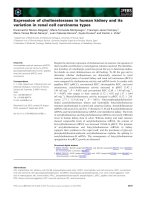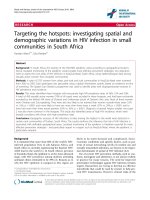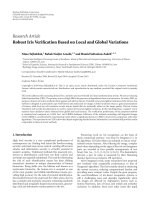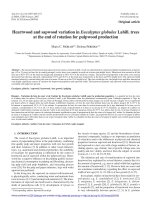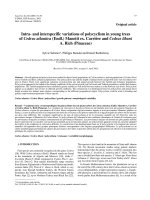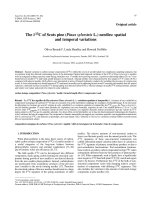Phonetic and phonology VARIATION
Bạn đang xem bản rút gọn của tài liệu. Xem và tải ngay bản đầy đủ của tài liệu tại đây (370.93 KB, 4 trang )
PHONETIC AND PHONOLOGY
VARIATION
VARIATION
I. Linking
1. Linking happens when we link words together, usually for ease of
pronunciation.
Example: Thousands of people. He eats and drinks.
/z əv/
/s ən/
2. Learners of English must be made aware of the problems that they will meet
in listening to colloquial,connected speech.
_ If a word ends with a consonant followed by another word beginning with a
vowel, the consonant is linked.
Example :
Give him a book.
// gi v im ə buk //
3. When a suffix beginning with a vowel is added to a word ending with r/re in
the spelling, / r / must be pronounced.
Example.: near /niə/ + er = nearer
/ niərə /
more / mƆ: / + over = moreover
/ mƆ:rəuvə /
4. If a word ending with r/re in the spelling followed by another word
beginning with a vowel, / r / is pronounced.
Example: for a week // fə rə wi:k //
here and there // hiər ən ðeə //
5. Native English speakers usually insert / r / after / a:, ə; Ɔ: / for ease of
pronunciation.
Example:
The idea of it / aidiər əv it /
1
PHONETIC AND PHONOLOGY
VARIATION
Raw eggs
/ rƆ: regz /
Ma and pa / ma: r ən pa: /
II. Elision
1. Elision is typical of rapid casual speech. Foreign learners do not need to
learn to produce elisions, but the perception of elision is important.
2. Elision is the complete disappearance of a sound.
3. / h / may be elided from he, his, her,have, has, had when these words are
unstressed and do not begin a sentenced.
Example: Where does he live?
/ weə də z (h)i: liv /
4. /t, d/ may be elided if they occur in the middle of a sequence of three
consonant sounds.
Example.: first time / fə:s(t) taim /
blindman / blain(d)mæn/
5. / ə / is frequently elided within words if the resulting sequence of cosonants
is an acceptable English cluster.
Example: / t(ə)r / 🡪 / tr / history /'hist(ə)ri/
/ s(ə)p / 🡪 / sp / surprised
/s(ə)'praizd/
6. When plosives occur in clusters with other plosives, the first plosive is elided.
/p, t, k, b, d, g/
Example.:
ca(p)tain
foo(t)ball
blac(k)board
ba(g)pipe
2
PHONETIC AND PHONOLOGY
VARIATION
III. Assimilation
1. Assimilation is the influence of one phoneme upon another neighbouring
phoneme, so that they become more alike.
2. Assimilation is more likely to be found in rapid, casual speech and less
likely in slow, careful speech.
3. Assimilation affects consonants only.
4. / t, d, n/ are likely to be replaced by
/p, b, m/ before bilabial /p, b, m/ and to
/k, g, ŋ/ before velar /k, g/.
/ t / +/p, b, m/ => / p /
/ d / + /p, b, m/ => / b /
/ n / + /p, b, m/ => / m /
/ t / +/k, g/ => / k /
/ d / + /k, g/ => / g /
/ n / + /k, g/ => / ŋ /
5. Word medial
/s/ + /j/ = / ʃ /
/z/ + /j/ = / ʒ /
Example : issue / 'isju:/ 🡪 / 'iʃu: /
azure / 'æzjə / 🡪 / 'æʒə /
6. Word medial /t/ + /j/ = / tʃ /
/d/ + /j/ = / dʒ /
Example:
7.
student / 'stju:dnt /
/ 'stʃu:dnt /
educate / 'edju:keit /
/ 'edʒu:keit /
/ s / + / ʃ / => / ʃ /
3
PHONETIC AND PHONOLOGY
VARIATION
/ z / +/ ʃ / => / ʒ /
4
